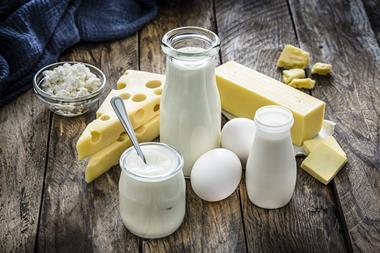>>brands help build milk sales, says David Whiting, marketing director of organic dairy farmers co-operative OMSCO
News that milk sales have enjoyed a small uplift for the first time in many years is a rare ray of sunshine for Britain’s beleaguered dairy farmers. According to the Milk Development Council, annual sales have declined over the past decade from 5.94 billion litres to 4.49 billion litres - a 25% drop. Considering that milk is as integral to our national culture as beer and tea, dairy farmers should be confident that, at the very least, sales will remain stable. So what on earth has been going wrong?
The abolition of Milk Marque gave rise to what was, until very recently, a highly fragmented dairy industry that focused on production and price as the key to increased sales. Aggressive competition between suppliers meant the price of milk declined - the retail price of a pint of whole milk has grown just 7.5p in cash terms since 1994. Yet there is little evidence to support the idea that price drives milk purchase - and the reduction has patently failed to prevent falling sales.
The flaw in the industry’s production-led thinking was clearly illustrated by the sad tale of the Amelca farmers co-operative. In 2002 Amelca developed a state-of-the-art milk processing plant for a reputed cost of around £20 million. Apparently assuming that processed milk could sell itself, Amelca failed to develop a strategic sales and marketing plan. The plant went into receivership after just three months.
The end result of this focus on price and production is a devalued and commoditised dairy market in which every part of the supply chain has lost out.
However, one sector of the liquid milk market that has seen steady growth over recent years is organic. Here, sales have been increasing by 30% year-on-year since 2002 and increased dramatically during 2005. The latest TNS figures show weekly sales running consistently 50% higher compared with the same time last year. Can anything be learned from the organic producers’ approach?
The UK’s leading organic dairy farmers co-operative, OMSCo, began its generic marketing campaign by investing in extensive market research. Surprisingly for many, this suggested that the primary opportunity for increasing organic milk sales lay not with environmentally-concerned shoppers, but with mainstream consumers who bought organic
occasionally and were largely motivated by health arguments. The research revealed how emotionally involved consumers are with milk, and that value - as distinct from low prices - was what consumers wanted.
OMSCo refocused its marketing strategy on encouraging occasional shoppers to buy more frequently. The campaign now communicates the health benefits of organic milk (that it is high in Omega-3 and antioxidants and is produced without GM feed, routine use of antibiotics, or pesticides) and the results can be seen in the growing sales figures.
Consumers’ emotional attachment to milk suggests that investing in brands will be essential to building the category. This is an area which producers and processors have largely avoided. The most notable exception has been Cravendale, the only major market-led UK milk brand until February this year when OMSCo launched its own, called Altogether Better. Following classic marketing principles, both brands have a clear point of difference, deliver a tangible benefit to consumers and are heavily supported by promotional activity to justify the price premium. No surprise then that both brands are delivering loyal consumers and healthy sales. Encouragingly, others have also recently appeared, including Robert Wiseman’s The One, but much more needs to be done to transform the milk fixture.
If we want to build a solid, sustainable market for liquid milk then we need to start investing in market research in order to inform targeted, strategic marketing plans. We need to co-operate more across the industry to develop joined-up, long-term promotion of the benefits of milk. And, above all, we need more brands which add real value to the category to re-engage consumers and help deliver healthy profits for all in the industry.
News that milk sales have enjoyed a small uplift for the first time in many years is a rare ray of sunshine for Britain’s beleaguered dairy farmers. According to the Milk Development Council, annual sales have declined over the past decade from 5.94 billion litres to 4.49 billion litres - a 25% drop. Considering that milk is as integral to our national culture as beer and tea, dairy farmers should be confident that, at the very least, sales will remain stable. So what on earth has been going wrong?
The abolition of Milk Marque gave rise to what was, until very recently, a highly fragmented dairy industry that focused on production and price as the key to increased sales. Aggressive competition between suppliers meant the price of milk declined - the retail price of a pint of whole milk has grown just 7.5p in cash terms since 1994. Yet there is little evidence to support the idea that price drives milk purchase - and the reduction has patently failed to prevent falling sales.
The flaw in the industry’s production-led thinking was clearly illustrated by the sad tale of the Amelca farmers co-operative. In 2002 Amelca developed a state-of-the-art milk processing plant for a reputed cost of around £20 million. Apparently assuming that processed milk could sell itself, Amelca failed to develop a strategic sales and marketing plan. The plant went into receivership after just three months.
The end result of this focus on price and production is a devalued and commoditised dairy market in which every part of the supply chain has lost out.
However, one sector of the liquid milk market that has seen steady growth over recent years is organic. Here, sales have been increasing by 30% year-on-year since 2002 and increased dramatically during 2005. The latest TNS figures show weekly sales running consistently 50% higher compared with the same time last year. Can anything be learned from the organic producers’ approach?
The UK’s leading organic dairy farmers co-operative, OMSCo, began its generic marketing campaign by investing in extensive market research. Surprisingly for many, this suggested that the primary opportunity for increasing organic milk sales lay not with environmentally-concerned shoppers, but with mainstream consumers who bought organic
occasionally and were largely motivated by health arguments. The research revealed how emotionally involved consumers are with milk, and that value - as distinct from low prices - was what consumers wanted.
OMSCo refocused its marketing strategy on encouraging occasional shoppers to buy more frequently. The campaign now communicates the health benefits of organic milk (that it is high in Omega-3 and antioxidants and is produced without GM feed, routine use of antibiotics, or pesticides) and the results can be seen in the growing sales figures.
Consumers’ emotional attachment to milk suggests that investing in brands will be essential to building the category. This is an area which producers and processors have largely avoided. The most notable exception has been Cravendale, the only major market-led UK milk brand until February this year when OMSCo launched its own, called Altogether Better. Following classic marketing principles, both brands have a clear point of difference, deliver a tangible benefit to consumers and are heavily supported by promotional activity to justify the price premium. No surprise then that both brands are delivering loyal consumers and healthy sales. Encouragingly, others have also recently appeared, including Robert Wiseman’s The One, but much more needs to be done to transform the milk fixture.
If we want to build a solid, sustainable market for liquid milk then we need to start investing in market research in order to inform targeted, strategic marketing plans. We need to co-operate more across the industry to develop joined-up, long-term promotion of the benefits of milk. And, above all, we need more brands which add real value to the category to re-engage consumers and help deliver healthy profits for all in the industry.



















No comments yet